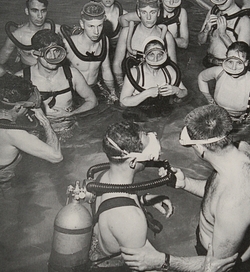|
History of
Scuba in the United States
Shortly following World War II, a wide interest in skin and scuba diving
developed in the United States. Small independent groups of divers sprang up in
organized clubs all over the country. In 1954, a group of YMCA, Red Cross, and
National Academy of Sciences experts encouraged the Council for National
Cooperation in Aquatics (CNCA) to take a look at the safety aspect of this
engaging and rapidly growing activity.

Material was outlined with a view toward setting up a course inclusive enough
to produce capable performance in those who elect to participate in this
recreational activity. Through the winter of 1954-1955 a test course was
directed by Bernard E. Empleton using this outline.
The material used in the course was then published as a textbook in 1957
under the title, "The Science of Skin and Scuba Diving". This text became "The
New Science of Skin and Scuba Diving" in the second edition and ultimately went
through six editions used by many agencies for over 15 years.
The YMCA, through Mr. Empleton, then developed its own course of instruction
and in 1959 adopted its own program and certified the first YMCA Scuba diving
instructors. This program was the first nationally organized course in the
field.
In 1972, the National Board of YMCAs to hired a full-time scuba director and
established a national scuba headquarters in Atlanta, Georgia.
In 1976, the YMCA SCUBA Underwater Activities Program was established. This
National Center for Underwater Activities was dedicated February 18, 1977 and
the Center provided administrative and technical support while advancing the
area of continuing education for recreational skin and scuba divers. The Center
also conducted a sophisticated program of research and development and operated
an underwater college for divers and those from other agencies including the
U.S. Army Special Forces and the U.S. Corps of Engineers divers. Scuba
instructors from all over the country participated heavily in the program.
 The YMCA SCUBA Program recognized the need
for a lifesaving course designed for scuba divers. In late 1977, a committee
was convened to consolidate the technology for Scuba Lifesaving and Accident
Management (SLAM) into a practical and concise package. The first book of this
type in the scuba industry was published in November, 1978 through the combined
efforts of several agencies. The YMCA SCUBA Program recognized the need
for a lifesaving course designed for scuba divers. In late 1977, a committee
was convened to consolidate the technology for Scuba Lifesaving and Accident
Management (SLAM) into a practical and concise package. The first book of this
type in the scuba industry was published in November, 1978 through the combined
efforts of several agencies.
In early 1980, the YMCA SCUBA Program achieved a unique status when the World
Underwater Federation (CMAS - Confederation Mondiale Des Activities
Subaquatiques) granted equivalency to YMCA SCUBA instructors and divers. This
distinction positioned the YMCA as part of the world's diving organization
composed of some 12,000 diving clubs, 65 National Federations, and 3.5 million
divers.
In mid-1985, the YMCA became part of a national committee to develop
Instructional Standards and Minimum Course Content for Entry-level SCUBA
Certification. On September 1, 1986, the standards were finalized and approved
by the major United States certification agencies. YMCA SCUBA became an active
member of the Recreational Scuba Training Council (RSTC) which is the
secretariat to the ANSI SCUBA Instructional Standards.
As the YMCA program approached its 50th year, YMCA of the USA made
a decision to sunset the program, thus ending the involvement of YMCA in scuba.
After the YMCA announcement, a group of former YMCA Scuba instructors led by
Tom Leaird, made a decision to begin a new agency with no connection to the
YMCA. The group organized a new agency, Scuba Educators International, to
continue the tradition of excellence.
|
